
Coyote Valentine Part 2 (The Worst Kind of Predator)
From Part 1: “So there I was—a scaredy cat surrounded by 100 predators……alone in a trailer in 30 below weather, and about to find out something terrifying. But Happy Valentine’s Day, right? ❤”
Part 1 describes my adventure of using half of a sabbatical year off from teaching at my community college to study ecosystems. And a piece of that study included two weeks at a coyote research station in the northwestern United States, parallel with the coyotes’ mating season that culminates around Valentine’s Day.
Some of the top coyote experts in the world worked at the university connected to the station, and I was able to wrangle an interview with a couple of them. I learned so much about the animals’ biology, social systems, and how they interact with other species, including humans. The scientists also taught me some of the methodology they used to conduct their studies. One of the most interesting and sad things I learned had to do with how ranchers place bounties on coyotes, meaning they reward those who hunt them, because the ranchers suspect coyotes kill their livestock. The research has shown that only the dominant alphas actually do this. Most feed on small mammals like mice, squirrels, and rabbits, which keeps those populations under control, plus birds, eggs and the occasional fruit or vegetable. Their status as omnivores means they can digest many kinds of food, something they have in common with us, and which contributes to their success.
Yet the ranchers are resistant to the science and continue to kill coyotes. And lest you think this only happens out on the range, no: I found out it was happening right in my own foothill neighborhood. As humans develop wild space into homes and mini-malls, other predators like wolves, mountain lions and bears lose their territory and risk becoming extinct. The wily survivalist coyote, however, has learned to creep onto side streets and into yards, looking for pet food … and sometimes small pets. People need to use common sense, realize that this is the risk of living on the edge, and keep their furbabies indoors. Instead, they bully government agencies into hunting the animals. No, the coyotes do not get relocated to somewhere more wild; they get ‘relocated’ to coyote heaven. Or is it hell? More on this in Part 3.
Now let’s get to the fun part: going into the blinds to observe the coyotes. The blinds were like little huts built in the large caged area of each coyote pair’s territory. Of course they saw me enter, and even though I stayed an hour or more and was very quiet, I always knew that they knew I was there. Much of their time was spent resting, or playing, or engaging in practice mounts, “doggie style,” that didn’t go anywhere. It was rare for me to actually see them successfully mate. We might be inclined to think that they were just shy, like we can be, but their reticence around humans has a different meaning. For wild animals, just like for us, mating is a vulnerable endeavor; it is only to be engaged in when the lovers feel safe. In this way, human presence can disrupt animals’ natural mating cycles and threaten their survival.
Equally important, though, the coyotes were also waiting for the exact brief period when the female was at her most fertile. How did they know? Because the male would sniff her genitals, and built into his DNA was the ability to smell the hormonal changes that indicated her ova, or eggs, were ready for nature’s big moment. What resulted, if all went well, was copulation and a “tie”—penile insertion and ejaculation, followed by a twisting motion that resulted in the honeys facing in opposite directions, with the penis still inside. That is a rough and rowdy process! It even seems painful but would be even more so if he withdrew. This is designed to let him continue to ejaculate and to keep his semen inside. We humans sometimes observe this in our dogs as “getting stuck together.” It promotes fertilization.
So there I was for the first few days, happily talking to experts, reading articles, and ‘preying’ upon my little predator subjects. I’d bundle up in long underwear, jeans and two shirts, two pairs of socks, my precious down coat, and hat, gloves and scarf to go spend an hour or more in a blind and sometimes again later to a different one. There were several spread across the acres of the research compound, with plans to build ever larger pens to more closely approximate the coyotes’ natural habitat.
I had plenty to do, but it was a few days before the Director had some time to spend with me. I was eager to talk with him because he’d told me he had a story to share that I would probably find interesting, given my background in human sexuality. What could that be! I wondered. Well, it was mind-blowing.
The very week before I arrived, there had been a trial, during which a man had been found guilty of murdering a teenage girl. That man had worked as a handyman at the research station. He had likely brought the girl there after everyone was gone. He had likely raped her, as two other young women testified that he’d raped them. And he had likely killed her there as well, after which he dismembered and burned her body out in the wide expanse of summer sagebrush between the coyotes’ territories–where investigators found her bones.
This story was disturbing on so many levels. I saw the burned area now covered in snow. I saw the observation building where it was believed the murder took place. I even saw blood spatter when I climbed the stairs and went inside that building. I thought about how terrified that young woman must have felt, alone with him in such a desolate-seeming place, with no one there to help her.
When I went to the library to read newspaper accounts, I learned that there was no forensic evidence linking him to the crime. It was all circumstantial. Granted, it was significant. He had even shot himself in the hand in a foolish attempt to make it seem as if an intruder had committed the crime. What a loser of a human being. People like him are one reason the word “predator” has come to signify something bad in people’s eyes. Real predators are beautiful creatures necessary to our ecosystems. He is the worst kind of predator.
But here’s what shouted out from between the lines to this scaredy cat about the lack of forensic proof: if, just if, a mistake had been made, and he was not the killer, then who was? It could be anybody. It could be the guard who let me in that first Sunday. Who sat at night in his kiosk not 50 yards away from my trailer. Who could easily jiggle open the flimsy lock on my rattletrap front door. I spent more time than I like to admit peering out from behind my curtains. Guarding the guard. Checking to see whether any other slippery shadow emerged under the glow of the one stadium light. Or just staring out at the blackness beyond, listening to the coyotes who were the innocent witnesses to a young girl’s horrific death.
More to come on coyotes, the killer and me in Part 3.
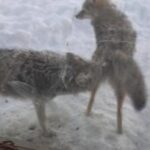
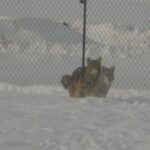
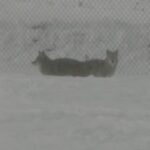
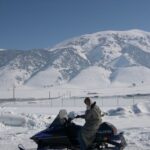
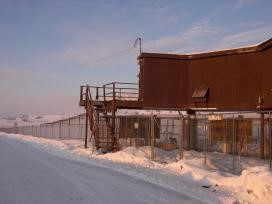

I am enjoying your blog. I love your writing
Thank you, Sherry! I hope you keep reading! 🙂
It’s really great you were able to learn so much about the coyotes and there lives.It sucks how there putting bounties on them when most of them had nothing to do with it they shouldn’t be hunted for just trying to survive.
Yes, they are just trying to survive – and we are the ones invading their territories!
Wow, you are strong! I think I would have packed my bags after hearing the murder story and seeing blood splatter on the stairs! It’s really sad to hear the horrible things we do to species that are essential to the ecosystem. It’s really sad that hunters are very careless and selfish in the sense that they do not educate themselves and think that violence is the only answer.
In this case, sadly, it is not just hunters to blame – it’s also people who want to live in wilder spaces but get rid of the animals that they think are inconvenient to them.
It is truly sad how bounties are upon coyotes by the request of ranchers for the benefit of themselves, i completely agree that coyotes are beautiful creatures necessary to our ecosystems and it is unfortunate ranchers cannot see that especially with how successful that are as you described.
The coyote information was interesting but that story was crazy your a brave woman I woulda left and I’m a boy.
Haha, I was motivated. For one thing, the college was paying me to do certain things, and if I didn’t do them I would owe that money back!
How amazing that you were able to experience something that is probably so rare for someone to see in their lifetime. One thing that stood out to me was the mention of the coyotes needed to feel safe enough to engage in mating and because they knew you were watching they were hesitant. Great read!
Thank you! That’s a feature of much of wildlife, to feel safe to mate. Which is why some will only mate when surrounded by their ‘tribe.’
Hello Lynda, after reading part one of Coyote Valentine and this blog entry as well I am amazed on how much you studied in different fields and with these coyotes as well. I also think its amazing that you were allowed to study them so freely and in such close proximity.
Daniel, wasn’t that amazing? It ranks as one of the high experiences of my life.
What a horrifying experience! It must have added a whole new layer to the coyote observation. I really admire your bravery and compassionate you show towards wild animals. Your story reminds me how important it is to respect wildlife and environment we share with them.
On the large scale, we’ve killed off so many species, and more will happen. On a smaller scale, we take an animal’s life – their one little life, just as we have our one little life. 🙁